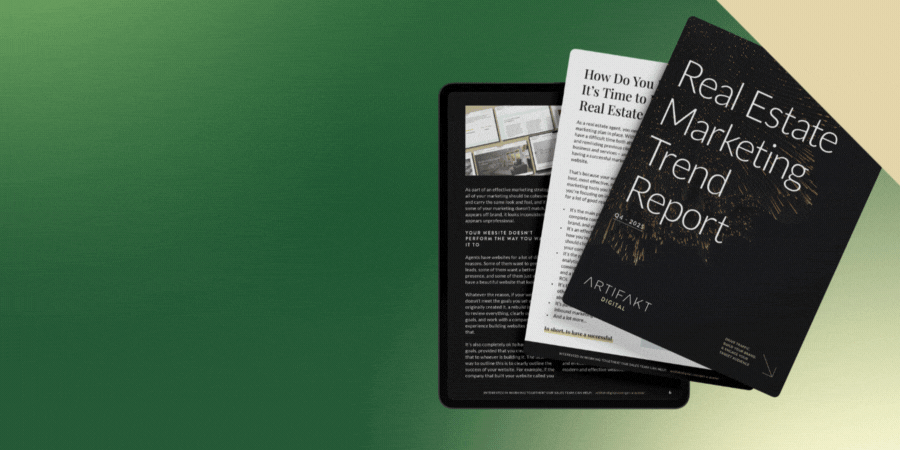Building a Lead Generation Strategy Through Education

Real estate agents are always looking for new ways to generate leads, but they’re also usually looking for a quick way to generate high-quality leads; if only it was that easy.
A better way to build quality leads is by positioning yourself as an authority to your audience through education, and that can be a lot of work to accomplish as part of your lead generation strategy, but it’s well worth the effort if you do it correctly.
Usually, it helps you get better results because you build trust with your audience; this is especially true for the leads you get that don’t want to transact right now (but potentially will in the future).
Not everyone will want to transact at this very moment, but they likely will someday. A big part of what you should be doing in your real estate marketing is making sure that when they’re ready to transact, they think of you, your brand, and your business.
You want them to remember that you helped educate them around a question that they had because if you answered it, you’ve built some trust, even if they’ve never heard of you prior to that.
When it comes down to it, building a lead-generation strategy through education can be a lot of work, but it’s worth it as part of your overall strategy because it can run in the background, 24 hours a day.
You can pay a company a bunch of money to generate leads for you, but those are most likely just going to be email addresses of someone that has a very low level of interest (if any) in you and your brand.
They won’t be the high-quality leads that love and trust your brand that you’re probably looking for.
That’s where an educational lead generation strategy can set you apart and help you build better leads. So how does it work? There are a number of ways you can educate your audience to position yourself as an authority to your target audience.
★ Want to learn more about lead generation? Have a look at these posts and resources:
- What To Do If You Have a Real Estate Lead Generation Problem
- Using Lead Source Tracking to Improve Your Lead Generation Plan
- Download Our Lead Management Workbook
1. Build Your Content Strategy
A lot of agents have a blog strategy, but few really think about what they’re writing and who they’re writing it for; most agents just write content for themselves or copy what others are doing.
Of course, the most important part of your ongoing content strategy is ensuring you’re writing content that your audience actually wants to read and finds valuable.
So what should you write about? Ideally, you should build your content strategy around educating people about what they want answers to.
By determining your target audience, and understanding what they’re interested in and what they’re searching for, you can build educational content that answers their questions.
Let’s say, for example, your target audience is primarily first or second time investors; it’s likely that these investors will want to know about the best opportunities as to where to invest next.
An educational content piece, perhaps even written monthly, (and optimized for search as part of your SEO strategy) that outlines opportunities of areas or specific properties that are great for investment can help draw them in. Even better, it shows them that you know what you’re talking about when it comes to investments.
If investors are reading your content consistently, you’re providing them value through education. During that process, there’s a good chance that you’ll build brand equity with them and that they’ll reach out to you about one of those opportunities (or about investing in general).
★ Want to learn more about content strategy? Have a look at these posts:
- Planning a Successful Content Strategy for Your Real Estate Website
- How to Plan Content that Attracts and Engages
- Optimizing Your Content for Humans (And Not Just for Search Engines)
- How (and Why) to Audit Your Real Estate Website’s Content
2. Build Your Email Newsletter Strategy
Getting people to actually subscribe to your newsletter is difficult, but if you’ve built a solid, educational-based content strategy that brings them to your website, and they like what they see, getting them to sign up is a lot easier.
Remember, a big part of writing content is to inform and educate, so if you do something like build a bi-weekly educational email newsletter, there’s a good chance they’ll actually see value in it and stay subscribed and engaged.
Let’s say, for example, your target audience is first-time homebuyers; it’s highly likely that they will have a lot of questions about buying their first home. Through an email newsletter strategy, you can build a drip campaign over two weeks that answers those questions for them.
For example: Are you a first-time homebuyer? Sign up here for my buyer newsletter series for everything you need to know about buying your first home. Delivered in easy-to-digest pieces, you’ll get a series of emails over a two-week period that helps you make an informed decision about purchasing a home.
The idea behind a newsletter strategy based on education is that you already have your audience’s attention, now you need to provide them value. You simply can’t ask for their business, you need to give them a reason not only to work with you but to transact in the first place.
While this might be more of a slow burn, when you build in the necessity to transact you build in the necessity and brand equity to work with you or your team for that transaction. You no longer need to convince a client of the right decision, because you already have through your marketing.
★ Want to learn more about email newsletters and email marketing? Have a look at these posts:
- Building an Effective Email Newsletter Strategy
- Why You Should Never Stop Building Your Email Marketing Database
- How Real Estate Agents Can Improve Their Email Marketing Open Rate
The Value of Content and Design
Writing good, high-quality content that provides value is really important, however, you can’t forget about the importance of design in this equation.
The fact remains: if your website, blogs, or newsletter don’t look good, they won’t earn the same kind of trust that your content needs to build real, long-lasting brand equity.
Design is imperative because it helps frame, position, and bolster your content. It makes it more readable, more engaging, and it also has the potential to bake in the CTAs that you require.
Take forms, for instance. If your blog isn’t designed with CTAs in mind, how will you be able to package your eBook into a form that can be strategically placed three-quarters of the way through your blog? It won’t exist, and you won’t give potential leads a reason to stick around.
When you think about content and design together, you need to think about “stickiness.” This is how well both are able to keep people sticking around, to keep them engaged, and to keep them returning. After all, returning users are converting users, and we want them to come back. Always.
★ Want to learn more about this? Have a look at this post called: Building a Real Estate Marketing Stickiness Strategy.
Building a Connection With Your Audience
Regardless of who your target audience is, there’s going to be some way to build value by educating them about the things they need to know most.
By doing so, you’re building trust and positioning yourself as a strong authority on the subject, and there’s a greater chance that when they want to transact, they’ll reach out to you.
With up to date marketing trends relevant to today’s market, our report is a selection of curated content, information, and data that will give you an outline of what’s working right now in real estate marketing.






















